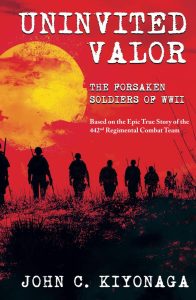‘Uninvited Valor: The Forsaken Soldiers of WWII” by John C. Kiyonaga is a compelling and informative story about a Japanese American fictional character named Joe Horiuchi, a high school English teacher living in Honolulu on Dec. 7, 1941. Horiuchi is a reluctant patriot who is torn between serving his country and fighting for a country that distrusts his loyalty solely because of his ethnicity.
 After volunteering for the Army, he is assigned to a mortar platoon in M Company, 2nd Battalion of the 442nd Regimental Combat Team.
After volunteering for the Army, he is assigned to a mortar platoon in M Company, 2nd Battalion of the 442nd Regimental Combat Team.
As a combat soldier, Horiuchi is not a gung-ho “Go for Broke” superhero. Rather, his story shares his mixed emotions after witnessing his friend being killed in action during his first combat encounter, killing his first German soldier, receiving a “Dear John” letter, fighting with the 442nd RCT in saving the Texas “Lost Battalion” and defeating the critical German stronghold atop of Mount Folgorita.
In writing this story, Kiyonaga fictionalizes the characters in the story and Company M in the 2nd Battalion but skillfully draws on the experiences of his father, Joseph Y. Kiyonaga, who served as a 1st Lt. in the 442nd RCT, to create an effective story for readers.
“Uninvited Valor” is an important read for two reasons. First, it allows the readers to understand the reasons members of the 442nd RCT volunteered to serve in WWII and the emotions combat soldiers felt as they fought in two of the 442nd RCT’s significant battlefield achievements.
Second, Kiyonaga lightly delves into then-California Attorney General Earl Warren’s motives as a leading advocate for the forced evacuation of all persons of Japanese ancestry from the West Coast and into President Franklin D. Roosevelt’s reasons for signing Executive Order 9066. The book’s discussion about EO 9066 is not definitive nor complete but raises two significant questions that are perhaps beyond the scope of the book’s story.
If Warren used war hysteria to promote prejudice, is his advocacy for the forced evacuation of ALL persons of Japanese ancestry from the West Coast evidence that he was a “white supremacist”? If EO 9066 is an example of racial profiling — issuing an adverse governmental action based solely on ethnicity — does President Roosevelt show that he was a “racist” by issuing EO 9066?
With the same valor shown by the legendary 442nd RCT during WWII to fight prejudice in America, the Japanese American community needs to continue the war against prejudice by pursuing answers to these questions. Until these questions are fully addressed and answered, the whole story about the Japanese American WWII experience cannot be accurately told. “Uninvited Valor” helps to start us on this journey.
“Uninvited Valor: The Forsaken Soldiers of WWII” is available for purchase at Amazon.com.



